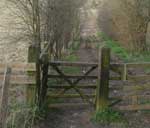Footpaths and rights of way usage
A quick guide to the number of different ways in which members of the public, or others, may have rights over your land


Few aspects of land ownership and usage are more contentious than the complex legislation relating to footpaths and rights of way.
As Saskia Arthur, a partner in City lawyers Boodle Hatfield, explains, there are a number of different ways in which members of the public, or others, may have rights over your land.
The title to your property (if it’s registered with the Land Registry) will record any private rights of way, which are generally restricted to a specific group of people such as neighbouring property owners, and are not meant for the public at large.
These will usually specify whether the right may be exercised on foot, with or without vehicles, and possibly with or without animals or machinery. However, it’s worth noting that in one recent dispute over a specific right of way relating to a very remote piece of land, the court decided that the drafting of the right of way gave the user a right to park— although in different circumstances, the interpretation might be different.
Public rights of way give the general public a right to use a designated part of your land as a highway at any time, and these are shown on ‘definitive maps’, which show the rights that exist at the time the map was drawn.
Sometimes, however, the maps are not so definitive, as not all rights are recorded,a situation that can lead to protracted and costly disagreements.
Based on the presumption of ‘once a highway, always a highway’, Natural England and other organisations have been keen to identify lost ways and have them recorded, but now Government funding for such projects has been abandoned.
Exquisite houses, the beauty of Nature, and how to get the most from your life, straight to your inbox.
Four types of public right of way are recorded on definitive maps, which can be checked with your local authority:
1. Footpaths—may be used on foot only 2. Bridleways—may be used on foot, on horseback, while leading a horse or riding a pedal cycle 3. Restricted byways—may be used on foot, on horseback, while leading a horse or using a vehicle that is not mechanically propelled 4. Byways open to all traffic (BOATs) — may be used on foot, on horseback and with or without motorised or other vehicles.
Some public rights of way remain in force until they’re closed or diverted, which may require action by the local authority, a court or Government department, or even an Act of Parliament.
This can be lengthy and expensive, with no guarantee of the eventual outcome.
* www.boodlehatfield.com
Country Life is unlike any other magazine: the only glossy weekly on the newsstand and the only magazine that has been guest-edited by His Majesty The King not once, but twice. It is a celebration of modern rural life and all its diverse joys and pleasures — that was first published in Queen Victoria's Diamond Jubilee year. Our eclectic mixture of witty and informative content — from the most up-to-date property news and commentary and a coveted glimpse inside some of the UK's best houses and gardens, to gardening, the arts and interior design, written by experts in their field — still cannot be found in print or online, anywhere else.

